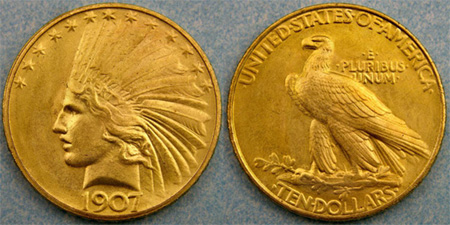The 1907 Indian Head Gold Eagle (Buy on eBay) with a rounded rim or rolled edge was created to solve the stacking problem experienced for the earlier wire rim version of the coin. This coin is considered to be a production issue, which is supported by the high initial mintage of 31,500 pieces. However, before the coins could be released to the public, all but 50 pieces were melted. Two additional pieces are known to exist in proof format.

The Chief Engraver of the United States Mint Charles Barber modified Augustus Saint-Gaudens’s original design by creating a thicker, raised rim. The previous wire rim made the coins difficult to stack and would have quickly worn away in circulation. Barber believed that his rolled edge would solve these problems and also serve to protect the high relief design from wear. The periods placed on the reverse before and after the words of the motto and denomination were retained.
After striking 31,500 pieces on a coining press, the Superintendent of the Mint John Landis was unsatisfied with the appearance of the coins, noting the significant loss of detail in the strikes. He preferred a third version of the design created by Saint-Gaudens’s assistant Henry Hering which was executed in lower relief with no periods on the reverse. This is the version which was ultimately adopted for full scale production and eventual public release.
All but 50 of the 1907 Indian Head Eagles with the rolled edge and periods were melted. The retained examples were privately distributed by the Mint and now represent a significant rarity. It is estimated that 35 to 45 specimens have survived with the majority in mint state grades. These coins now represent the absolute key date to a set of circulation strike Indian Eagles. The auction record is held by a piece graded PCGS MS-67, which sold for $576,000 in 2020.
There are two known examples in satin proof format, which may have been struck as trial pieces. The coins feature bold strikes and are believed to have been produced on a medal press. One of the specimens was offered at auction in 2002, but failed to meet its reserve. The other known specimen, which can be traced back to the collection of United States Mint Director Frank A. Leach, was sold for a record $2,185,000 in 2011.

